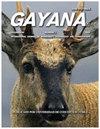智利南部温带湿地黑颈天鹅(Cygnus melancoryphus)摄食生态的季节性
IF 0.4
4区 生物学
Q3 Agricultural and Biological Sciences
引用次数: 0
摘要
与食物的可得性和质量有关的环境物理限制的附带影响最终将影响野生动物的能量收支。本研究旨在确定季节性对智利布迪湖黑颈天鹅水位、行为和营养状况的影响。在冬季和春季,用刻度杆记录水位,从早上8点到下午6点,用双筒望远镜和聚焦法记录60只天鹅/小时的时间预算。为了确定营养状况,捕获了20只鸟,测量了它们的体重、长度、翼展和跗骨长度。同时,采集血样测定胆固醇、甘油三酯和总蛋白的血浆浓度。布迪湖冬季水位升高(111 ±3 cm vs 54 ±0.6 cm, P = 0.04)。此外,与春季种群相比,冬季种群在早晨觅食的时间和费力觅食行为的比例(37/222比14/185,P = 0.01)显著增加,而休息活动的时间(7 ±4%比11 ±2%,P = 0.05)显著减少。在这两个季节,天鹅种群的营养状况没有受到损害。综上所述,尽管冬季水位上升,但行为调整使黑颈天鹅种群保持足够的营养状态。本文章由计算机程序翻译,如有差异,请以英文原文为准。
Seasonality in the feeding ecology of Black-necked swans (Cygnus melancoryphus) in a temperate wetland of southern Chile
The concomitant effects of environmental physical constraints associated with the availability and quality of food will finally affect the energy budget of wild animals. This study aimed to determine the effect of seasonality on water level, behavioural and nutritional status of Black-necked swans inhabit the Budi Lake, Chile. In winter and spring, the water level was recorded using a graduated rod and a time budget of 60 swans/hours was recorded from 8 am to 6 pm using binoculars and the focal method. In order to determine nutritional status a subset of 20 birds were captured and weight, length, wingspan, and tarsal length were measured. Also, blood sample was collected to determine cholesterol, triglycerides, and total proteins plasma concentrations. Budi Lakeâs water level increase in winter (111 ± 3 cm vs 54 ± 0.6 cm, P = 0.04). In addition, winter swan population increased significantly the time allocated to foraging at morning, and the proportion of effortful foraging behaviour (37/222 vs 14/185, P = 0.01), assigning less time to resting activities (7 ± 4 % vs 11 ± 2 %, P = 0.05) compared with spring population. Nutritional status was not compromised in swan populations in both seasons. In conclusion, behavioral adjustments allow Black-necked swan populations to maintain an adequate nutritional status despite the increase in water level during winter season.
求助全文
通过发布文献求助,成功后即可免费获取论文全文。
去求助
来源期刊

Gayana
ZOOLOGY-
CiteScore
1.30
自引率
0.00%
发文量
5
审稿时长
>12 weeks
期刊介绍:
GAYANA is a scientific journal published by Universidad de Concepción, Chile. It is the modern version of Gayana Oceanología and Gayana Zoología. Therefore its numeration starts at volume 63(1).
GAYANA covers all aspects of zoology and oceanographic research. It is structured in five sections, defined by subject or discipline: Ecology, Biodiversity and Taxonomy, Earth Sciences, Evolutionary, and Applied Biology and Environmental Biology. Each section is in charge of an editor who receives and manages the manuscripts sent for evaluation in close collaboration with the editorial board.
 求助内容:
求助内容: 应助结果提醒方式:
应助结果提醒方式:


